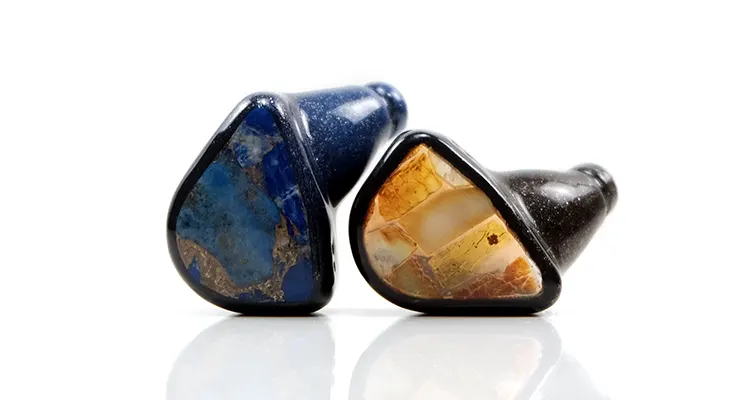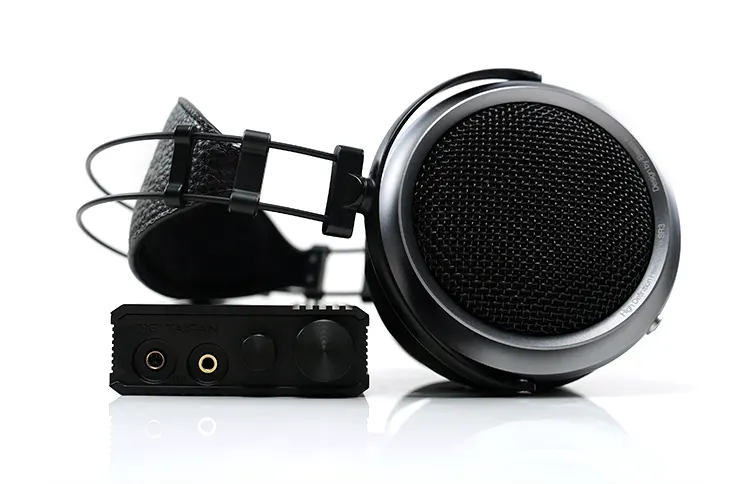Sound Impressions
The following sound impressions of the D16 Taipan were completed using a mix of the PMG Audio Apx, the ZMF Headphone BOKEH, and the iBasso DX320 MAX Ti‘s coaxial output for the main source.
Summary
The D16 Taipan is a flexible device that excels with almost any IEM and a wide range of dynamic and planar driver headphones.
Its core tonal coloration is natural to neutral with a distinctly analog overtone compared to the likes of the Hugo 2. It’s not too heavy on the lows either yet somehow, the instrument and vocal note weight with most pairings still sounds subjectively physical and robust throughout.
Two key strengths of the D16 stand out to me throughout this review process; an open and tall soundstage with an impressive holographic dimension and an outstanding level of character and detail in note texture I tend to associate with desktop R-2R DACs.
I should say it’s very different from a typical delta-sigma sound signature. It does not sound overly polished and pitch-perfect in its delivery. In some ways, it is also a little more relaxed and not as driven-sounding as Delta Sigma competitors such as the ONIX Mystic XP1.
Vocal presence in particular is excellent with the D16. Both the Bokeh and the Apx delivered copious amounts of space to allow what can be best described as a life-like and richly textured vocal delivery to leap out in recordings.
Nothing sounds overly processed with the D16, if there are vocal imperfections, or anything exaggerated from the mic distance or lack of pop filter then you will hear it from the D16.
One important observation is the superior performance of the coaxial input over the USB equivalent. I found the coaxial performance to offer a more holographic soundstage and a smoother, firmer tone. Especially so with higher pitching percussion timbre which came across as slightly harder-edged and brighter via USB.
You can also throw in an impressive level of granular control for gain and volume levels allowing you to set the perfect parameters for sensitive and demanding headgear.
Coloration
I have heard a few PWM-DACs over the years and they rarely color the sound in the same manner. The D16 is no exception with perhaps one of the most analog-sounding PWM-DACs that I have personally heard to date.
HiBy and Chord have opted to go with a clean high-resolving tonal quality to their interpretations with Chord perhaps the most resolving and harmonically balanced of the competing offerings.
The D16 moves away from what I would call “resolution gymnastics’ and instead it takes a leaf out of the R-2R and classic 1BIT book with a focus on building up the ‘life-like’ quality of vocals and instruments free from obvious oversampling.
It has a smoother tone, perhaps a little slow-paced in its delivery compared to the speed and complexity of the Hugo 2 but the note texture and definition are of the highest quality.
Nuanced vocal fry notes and diaphragmatic breaths are etched with fantastic detail making regular delta-sigma equivalents somewhat bland and overprocessed sounding.
The lows on the D16 come across as relatively neutral with all of my pairings during the review process. Other amplifiers such as the XP1 deliver a comparatively elevated bass shelf that colors the sound more extensively.
That type of elevated bass shelf tuning pairs well with leaner-sounding headphones such as the DCA E3 but less so with more boisterous closed-backs such as the BOKEH. The D16 tight bass control was an asset with the BOKEH’s bombastic tuning, keeping bass bloom well in check.
Staging & Dynamics
The D16 creates what I would describe as a very life-like or natural soundstage quality to most of the paired gear I tested it with.
What I mean by that is it’s not a magical tool to hugely alter the IEM or headphone’s presentation, sounding quite transparent and honest in that manner.
However, what it does within that soundstage is where the magic is with a deep and holographic set of mids, excellent vocal presence, and an exceedingly black background.
I would describe bass weight as accurate without any overt elevation but at the same time, the sub-bass extension and fundamental frequency are unhindered so notes throughout have a nice firm planted quality to them.
The dynamic range is impressive, nothing sounds smeared or compressed in their delivery. Particularly so with the coaxial connection which can sound effortless compared to the slightly ‘squeezed’ sounding USB performance.
The only caveat is when you start scaling up with demanding headphones that require plenty of power. For example, the stronger voltage output of OTL amplifiers such as the Feliks Audio EUFORIA evo can produce a firmer set of lows, filling out more demanding high-impedance headphones in a more satisfying manner.
I suspect this is where the D16 as a pure DAC combined with something like the soon-to-be-reviewed PB5 Osprey amplifier will be a difference maker.
Synergy
Flexibility
The D16 Taipan is rated at a maximum of 1125mW from its balanced PO on a 32Ω load dropping to 640mW using its single-ended 3.5mm output.
For a portable amplifier that is quite good for single-ended and though not the highest rated out there for balanced power, (FiiO’s Q7 can deliver up to 1.5W), the 1.125W should cater to plenty of modern planar and dynamic driver headphones.
However, sheer power is not the defining trait, but rather the flexibility the D16 has in allowing you to fine-tune multiple parameters for gain and volume control with sensitive gear right up to more demanding headphones.
Not only is there excellent channel balancing from the same stepped potentiometer inside the DX320 MAX Ti but it can be combined with a DAC digital pre-amp control and separate gain levels for the DAC and Amp (high and low) for even more granular control.
With sensitive IEMs such as the Vision Ears VE10 and Campfire Audio’s Fathom, you can tailor individual absolute silence gain and pre-amp volume levels to suit each.
For both, I found a 50-step DAC volume level worked best to create a pitch-black background with no low-level audible signals heard when the stepped potentiometer was also at zero.
From there, you just work your way up with the stepped potentiometer to a reasonable volume level then tweak the DAC volume up or down slightly to perfect your desired audible level.
Coaxial or USB?
I encourage you to use the coaxial input to the D16 rather than the USB interface. It is the better option performance-wise.
I should preface this by saying I have been on a bit of a journey over the last year or so, moving away from USB for digital playback where possible and going with either I²S or in this case adding coaxial to the mix.
Generally, I have found the more you can isolate from interferences such as AC power or the noisy PC the better the performance. Also, there are some limitations to the USB chipset that can subtly color the sound which is the case here with the D16.
I found the coaxial pairing to be the smoother-sounding of the two, particularly through the mids and highs where I perceived more extension or headroom creating a taller and more open soundstage.
The USB input from the DX320 MAX Ti and a Samsung S23 Ultra delivered slightly harsher vocals, a bit of metallic overtone on some percussion, and slightly compressed in the lower treble using the Vision Ears VE10. Arguably, it sounded more digital and less inviting than the coaxial performance.
IEM Pairings
I tested a few IEMs of various configurations and price points with the D16 Taipan’s balanced output using the DX320 MAX Ti as my source via a coaxial connection.
I have to say it’s hard to declare any bad pairings but at the same time, the D16 will not magically color an IEM’s performance if that is what you are looking for in your amplification.
Instead, I found the perfect IEM pairings more in how open the mids sounded with the D16 pairing. In some cases, this made a difference such as the First Light which I tend to find a little dark through the mids and highs and not quite as clean or as well-defined as some of the competition.
This pairing sounded airier than I expected and not quite as dark as with some regular DAP pairings from my earlier review.
That theme continued with the PMG Audio Apx and SE version, two top-tier performers. Of these two, I felt the original Apx was the superior pairing. Its immersive soundstage gels so well with the D16’s open staging quality that I suspect this might be my go-to pairing for some time.
The SE did very well with vocals, sounding smooth and balanced throughout. However, it did not deliver the same addictive wide and holographic imaging of the D16/Apx pairing.
What surprised me the most was the Apx’s treble performance out of the D16. I was maybe expecting it to be feisty but somehow it sounded firm and physical but without any sharpness.
The D16/VE10 was another excellent pairing. Its smooth tuning and excellent bass weight sounded more balanced and holographic than I used. The bass sounded tighter, the mids more open and the treble had a little more sparkle.
Headphone Pairings
I tested a few headphones of various impedance and SPL levels using the same setup as the IEMs and came away with a stronger opinion of headphone matching preferences compared to the IEM process.
Some of that is purely down to personal taste. For example, I prefer a warmer and weightier amp and source such as the Mystic XP1 when pairing with the DCA E3.
The D16 pairing was more resolving, much better through the mids, and generally projected a more open and taller soundstage. However, some leanness in the E3 lows pushed the midrange timbre more to the brighter side than the XP1.
The E3 can be naturally bright so I use the XP1 more to color it a bit smoother and beefier rather than the D16 creating that brighter tone. I should add that for a headphone with an SPL of -90 dB/mW there was enough headroom from the D16 to drive it.
The 150Ω iBasso SR3 sounded very detailed, wide, and tall but too neutral on the lows for my tastes. The DX320 MAX Ti’s PO sounded firmer to my ears as did proper desktop OTL amps such as the Feliks Audio EUFORIA evo.
For dynamic drivers, the D16 sounded excellent with the 80Ω BOKEH from ZMF. At around 450mW power into 80Ω from the D16 is more than enough for the BOKEH and indeed it sounded lively and surprisingly pacey in its delivery.
One thing I have to note, the D16 does very well with closed-back headphone pairings when set on its high gain and using a balanced output.
Paired with the BOKEH, its bass bloom was kept under check, with a very punchy mid-bass with a deep soundstage that belied its closed-back design. Probably my favorite of the headphones pairings.







